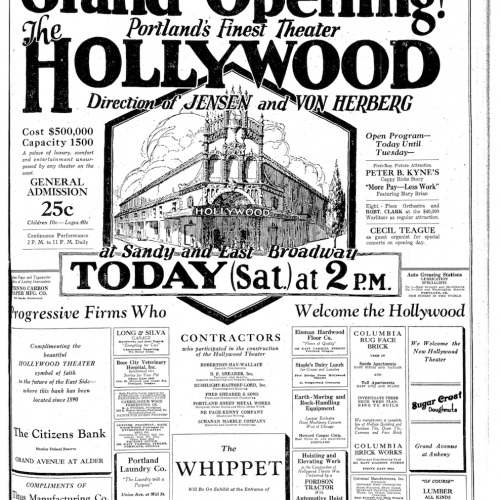On Saturday, July 26, 1926, an advertisement was posted in The Morning Oregonian announcing the “Grand Opening!” of “Portland's finest theater,” the Hollywood. The advertisement gave the address of the theater, “at Sandy and East Broadway,” the time and day of the grand opening, Saturday at 2 P.M., and the capacity of the theater which was 150 people. The ad also boasted that Jensen and Von Herberg had “directed” the building of the theater, which cost $500,000, and that it was “a palace of luxury, comfort and entertainment unsurpassed by any theater on the coast.” To put that in perspective, $500,000 in July of 1926 is the equivalent of $7,300,000 in January of 2020, which provides an idea of the large investment in the theater. The ad also named and gave thanks to all the contractors who participated in the construction of the theater, and in the right column announced the theater would be playing the film “More Pay-- Less Work” by Peter Kyne. The ad went on to advise that there would be an eight-piece orchestra, with special guest organist Cecil Teague performing on opening day. In the left column of the ad was shown the admission price of 25 cents for general admission, 10 cents for children, and 40 cents for loge seating.
At the very bottom of the advertisement there was a collection of smaller advertisements for “Progressive Firms Who Welcome the Hollywood,” including ads for contractors, suppliers, service providers, stores and a restaurant. I found this to be an interesting promotional strategy, where various “progressive” advertisers bought a space on an advertisement in support of the Hollywood Theater. I surmise that, between the mention of “Progressive Firms” and the opening film’s title (“More Pay-- Less Work”), the Hollywood Theater had a “progressive bent,” with pro-labor films and the backing of a similarly-progressive community and attendees.
In addition, it appears that a number of these “progressive” advertisers were physically located near the Hollywood Theater. This is a marketing concept that makes sense and proves to work time and time again. Having seen the ads for these firms, Hollywood Theater attendees might be more inclined to stop in to the nearby advertisers, particularly where the attendees are politically in sync with the Hollywood Theater and the “Progressive Firms.” It is only natural that the Hollywood Theater attendees would be inclined to visit/use the nearby, progressive advertisers. For example, people would see the huge ad for the Hollywood Theater’s Grand Opening and might decide they wanted to attend the theater. Their eyes would then move down the advertisement and see that the progressive “Staples Dairy Lunch (Ice Cream and Lunches” was advertised as being located just “Five Blocks” from the Hollywood Theater. Because the progressive Staples Dairy was so close to the progressive Hollywood Theater, the ad viewer might very well have been intrigued by or at least have considered eating lunch at Staples Dairy before they attended the Grand Opening of the Hollywood Theater at 2 P.M. That is progressive, effective advertising!
Oregonian, 17 July 1926, p. 9. NewsBank: America's News – Historical and Current, infoweb.newsbank.com/apps/news/document-view?p=AMNEWS&docref=image/v2:11A73E5827618330@EANX-NB-129ECFD01D1E183E@2424714-1294E2F3F2B9566A@8. Accessed 14 Feb. 2020.
